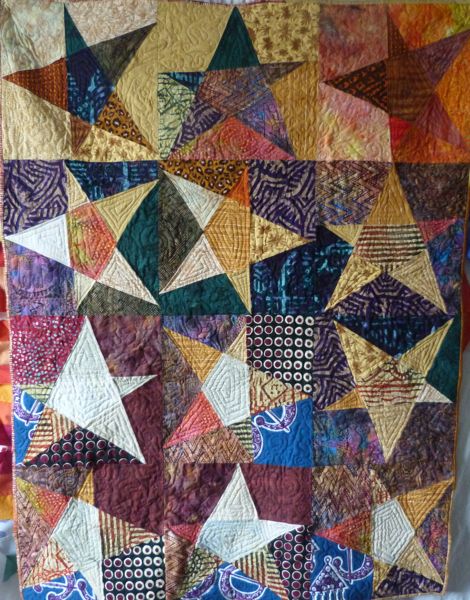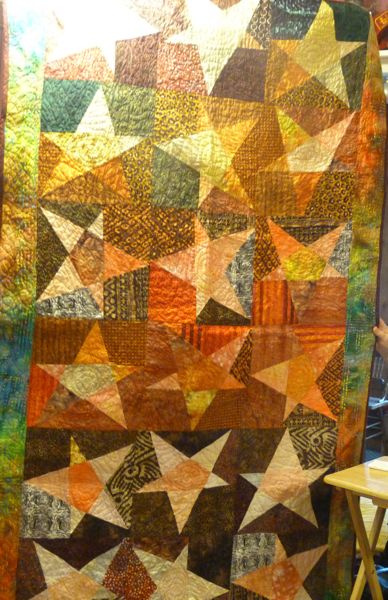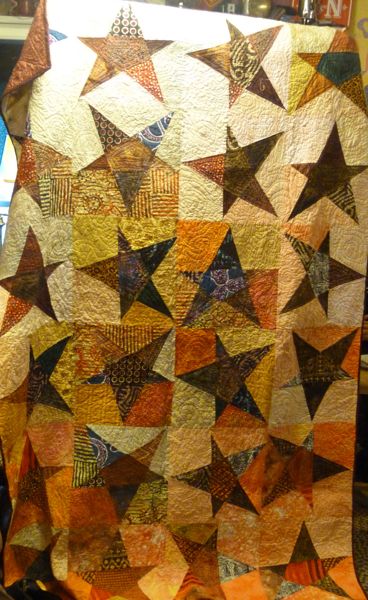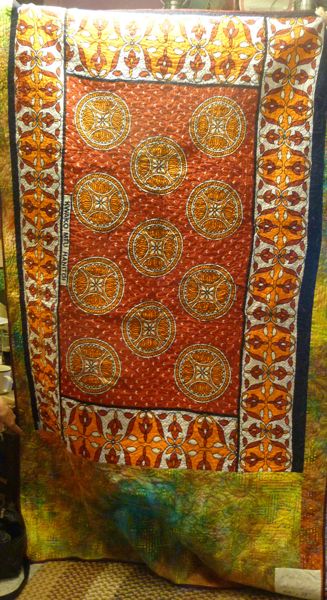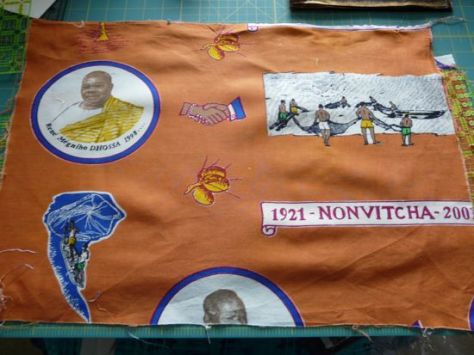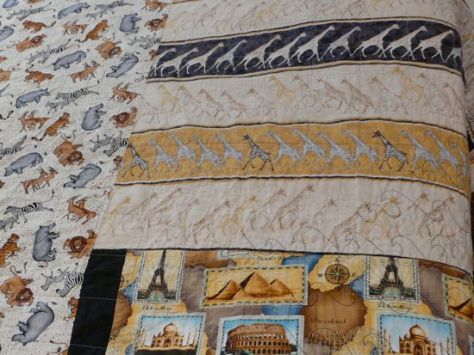I know it looks like I haven’t been producing for a while and to some extent, it is true. I am working on a mystery quilt, I am working on a serious hand applique border to a pineapple quilt, and I have finished a few little projects but I forgot to photograph them, and once they are gone, they are gone, sometimes I don’t even remember I did them!
This one I just finished, and it was a labor of love.
In June of last year, a dream came true – we were able to take our son and our daughter-in-law on safari with us in Zambia. We stayed in the Robin Pope Camps – Tena Tena, Nsefu and Nkwali – and a second dream came true – at Nkwali, we stayed in the famed Robin’s House, which was pure heaven for a party of four who would then be going in separate direction. A third dream came true – they loved the trip as we hoped they would.
I had intended to make this quilt all along – for our son and his wife – and I started it, and had a lot of fun with it. I’ve been collecting fabrics forever with an African theme, and then a good friend had spent several years in Africa and I begged for some scraps from her, which she gladly and generously gave me.
Then my husband had a trip scheduled to the states unexpectedly, and I have an opportunity to get the quilt sent back with him. It hurried the process a little. I had it all put together and machine quilted, but I wanted to quilt some animal tracks on the paths. More on that later.
I don’t have a way to hang the quilt properly to get a good full scale photo – the quilt finished size is 84″ x 84″ – so I put it on the floor, climbed a ladder, shot the quilt and then tried to shop out all the background, so that is why it all looks so funky.

My husband says he loves this one almost as much as I Left My Heart in Africa.
I started with the Elephant tracks:

The elephant tracks took a lot longer than I had thought they would. I had done them on the entire path. Time is growing short. I did one set of lion prints:

And then, nearby, I did one set of impala tracks:

That is going to have to do. I told my husband, whose tracking book I had used to do the animal prints, that the hungry lion was waiting in the bush and ate the impala, and that is why there are so few lion and impala prints. :-0
Here is the label on the back (you can see the backing fabrics on the entry for March 2, 2009)

The rest of this entry is purely for people who love fabrics. You have been warned. 🙂
There is one fabric in this quilt that is almost thirty years old. It is the remainder of three meters of fabric I bought when we lived in Tunisia, lo, these many many many years ago. I loved it then, and I love it now. It has been in all three of the Africa quilts, in many other quilts made for family members and close friends, and now I am down to mere scraps, fortunately, enough to include in this quilt, because Tunisia, although North African, is truly also Africa. The pattern featured Bedouin jewelry patterns, the hand of Fatima, crescents, special pins to hold the sefsari together at the shoulders – and it is in turquoise and purple (be still my heart!) with black and white accentuation. Here it is featured in the center, and the second scrap is in the upper right quadrant of the quilt:


I was really really lucky to have a good friend who had also lived in Africa – she shared some scraps with me. There are people who might think some of them are ugly – an artist friend of mine told me once long ago “there are no ugly fabrics, only people lacking in imagination.” She also told me “the eye will blend!” two mantras I repeat to myself when I start obsessing over just the right fabric or just the right placement. She was right. You can cut chunks out of fabrics, any fabric, and make it work. There are some really really fun fabrics in this quilt:

Don’t you just love it? This one was from a big orange, very orange celebration of Gabon’s independence!

This fabric was from Senegal; don’t you love the digitalized palm tree?
I will admit, it was a challenge for me working in browns and yellows, not my favorite palette at all, but I find when I force myself out of my comfort zone, I grow, and learn to see thing in new ways. Some of the colors here I really did not like, but my artist friend was right – the eye will blend. Africa is a country of enormous diversity, and the quilt incorporates some wildly disparate colors, prints and values.








African Pathways is made with two simple blocks – a hatchet block, sometimes also called an anvil, and a 4 patch. In this quilt, all blocks were 4″ finished. The hatchet block is made by stitching a 2 1/2 incl square diagonally across opposite corners (diagonally) and cutting off the excess, leaving a 1/4 inch seam, flipping the top down and ironing, and a four patch is made up of 4 smaller blocks, cut 2.5 inches.
I have a friend who is a beginning quilter. When I showed her how the quilt was made, she said “Oh! I could do that!” It was an Obama moment – “Yes. You can!” 🙂 This quilt pattern is a real confidence builder, and a great teaching quilt.
There are many, many ways these flexible blocks can be put together. Other quilts using these blocks are here:
Hugs and Kisses
Reciprocals
Black and White and Blood all Over
Quick Quilts for Charity (Instructions for making two hatchet block quilts)
Here is my computer plan for the quilt; having the grid all mapped out helped me to plan the pathways and to know how many of each fabric to cut for pathways, how many 2 1/2 inch squares to cut for the 4-patches, and how to place them. The quilt is built in quadrants and then sewn together.

Happy Anniversary, lovebirds. 🙂
















